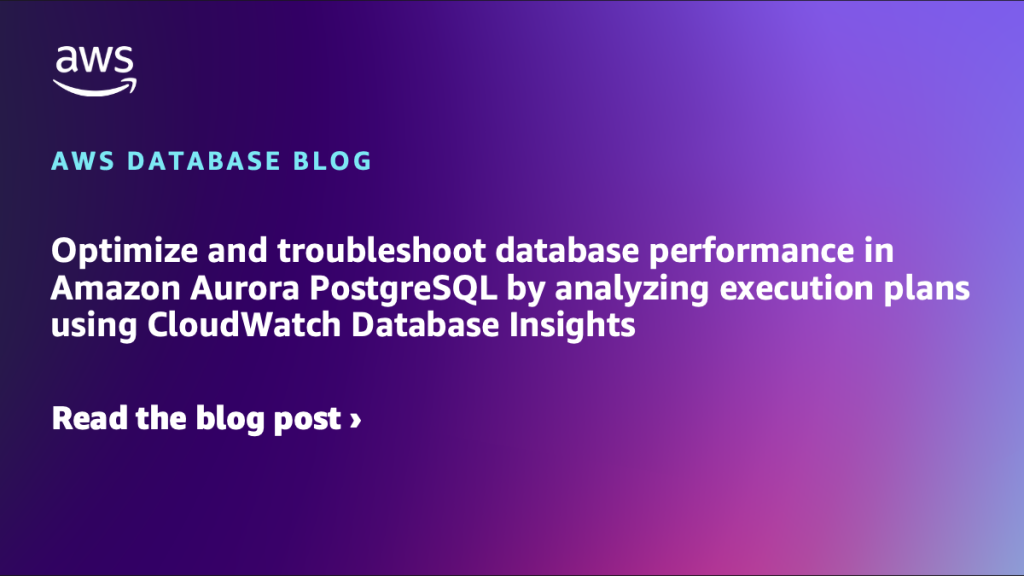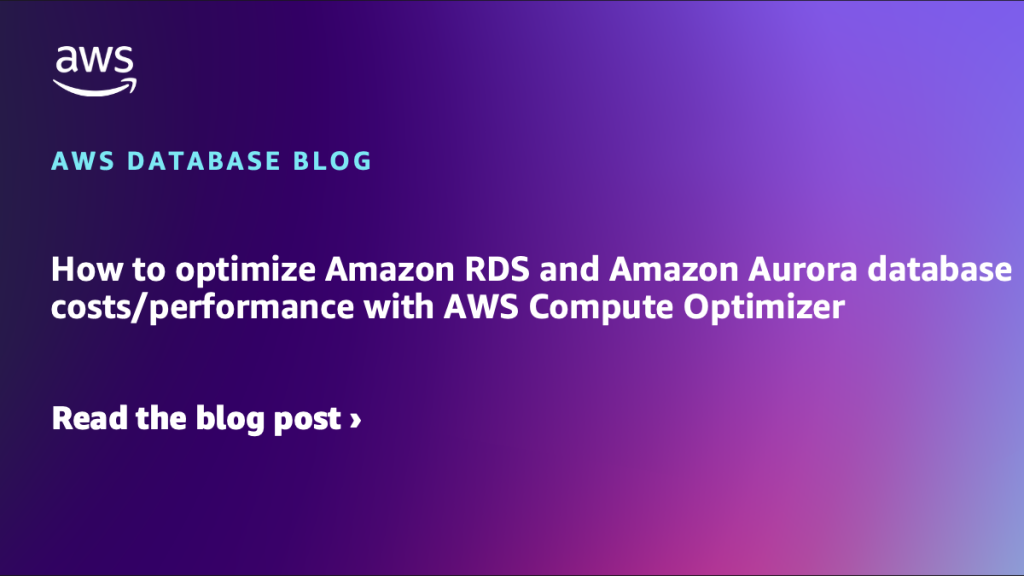AWS Database Blog
Category: Management Tools
AI-powered tuning tools for Amazon RDS for PostgreSQL and Amazon Aurora PostgreSQL databases: PI Reporter
In this post, we explore an artificial intelligence and machine learning (AI/ML)-powered database monitoring tool for PostgreSQL, using a self-managed or managed database service such as Amazon RDS for PostgreSQL and Amazon Aurora PostgreSQL.
Optimize and troubleshoot database performance in Amazon Aurora PostgreSQL by analyzing execution plans using CloudWatch Database Insights
In this post, we demonstrate how you can use Amazon CloudWatch Database Insights to analyze your SQL execution plan to troubleshoot and optimize your SQL query performance in an Aurora PostgreSQL cluster.
How to optimize Amazon RDS and Amazon Aurora database costs/performance with AWS Compute Optimizer
In this post, we dive deeper into database optimization for your Amazon Relational Database Service (Amazon RDS), exploring how you can use AWS Compute Optimizer recommendations to make cost-aware resource configuration decisions for your MySQL and PostgreSQL databases.
Automate Amazon RDS for PostgreSQL major or minor version upgrade using AWS Systems Manager and Amazon EC2
In this post, we guide you through setting up automation for pre-upgrade checks and upgrading a fleet of Amazon RDS for PostgreSQL instances. In this solution, we use AWS Systems Manager to automate the Amazon RDS upgrade job.
Amazon CloudWatch Database Insights applied in real scenarios
In this post, we show how you can use Amazon CloudWatch Database Insights for troubleshooting your Amazon RDS and Amazon Aurora resources. CloudWatch Database Insights serves as a database observability solution offering a tailored experience for DevOps engineers, application developers, and database administrators. This tool is designed to accelerate database troubleshooting processes and address issues across entire database fleets, enhancing overall operational efficiency.
Monitor Amazon DynamoDB operation counts with Amazon CloudWatch
Amazon DynamoDB continuously sends metrics about its behavior to Amazon CloudWatch. Something I’ve heard customers ask for is how to get a count of successful requests of each operation type (for example, how many GetItem or DeleteItem calls were made) in order to better understand usage and costs. In this post, I show you how to retrieve this metric.
Import Amazon RDS Enhanced Monitoring metrics into Amazon CloudWatch
In this post, we show you how to import multiple Enhanced Monitoring metrics to CloudWatch and use the full capabilities of CloudWatch on those metrics.
Enable fine-grained access control and observability for API operations in Amazon DynamoDB
Customers choose Amazon DynamoDB to improve their applications’ performance, scalability, and resiliency. DynamoDB’s serverless architecture simplifies operations by abstracting hardware, scaling, patches, and maintenances. Managing data access and security in DynamoDB is different than instance-based database solutions. DynamoDB uses AWS Identity and Access Management (IAM) to authenticate and authorize access to resources, whereas RBDMS solutions rely on firewalls rules, […]
Programmatic approach to optimize the cost of Amazon RDS snapshots
One of the key benefits of Amazon Relational Database Service (Amazon RDS) is that it creates an automated storage volume snapshot of the database instance, backing up the database host at the instance. Amazon RDS saves the automated backups of databases according to the specified backup retention period. The flexibility of creating manual snapshots helps […]
Mask sensitive Amazon DocumentDB log data with Amazon CloudWatch Logs data protection
Amazon DocumentDB (with MongoDB compatibility) is a highly efficient, scalable, and fully managed enterprise document database service designed to handle native JSON workloads. Amazon DocumentDB simplifies storing, querying, and indexing JSON data as a document database. The Amazon DocumentDB profiler feature is a valuable tool for monitoring the slowest operations on your cluster to help […]









